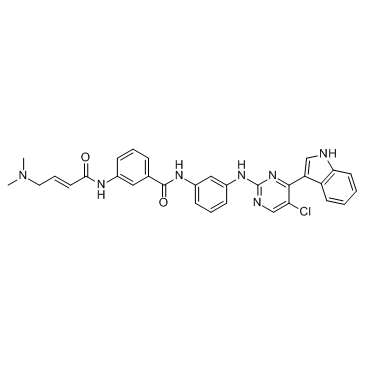| Cas No.: | 1604810-84-5 |
| Synonyms: | THZ-2,THZ2,THZ 2 |
| SMILES: | O=C(NC1=CC=CC(NC2=NC=C(Cl)C(C3=CNC4=C3C=CC=C4)=N2)=C1)C5=CC=CC(NC(/C=C/CN(C)C)=O)=C5 |
| Formula: | C31H28ClN2O2 |
| M.Wt: | 566.05 |
| Purity: | >98% |
| Sotrage: | 2 years -20°C Powder, 2 weeks 4°C in DMSO, 6 months -80°C in DMSO |
| Description: | THZ2 is a potent and selective CDK7 inhibitor with an IC50 of 13.9 nM. |
| Target: | CDK7:13.9 nM (IC50) CDK1:96.9 nM (IC50) CDK2:222 nM (IC50) CDK5:134 nM (IC50) CDK9:194 nM (IC50) CDK8:6830 nM (IC50) |
| In Vivo: | THZ2 (10 mg/Kg) markedly reduces the growth rate of tumors in mice and demonstrates an anti-tumor activity. Compared to vehicle-treated tumors, tumor tissues isolated from mice treated with THZ2 has reduced proliferation and increased apoptosis, as indicated by immunostaining against Ki67 and cleaved Caspase 3 respectively. THZ2 in NOD-SCID mice leads to reduced body weight, suggesting that THZ2 mayt be less well-tolerated in this particular mouse strain[1]. |
| In Vitro: | THZ2 selectively targets CDK7 and potently inhibits the growth of triple-negative but not ER/PR+ breast cancer cells. THZ2 at low nanomolar doses also efficiently suppresses the clonogenic growth of TNBC cells with IC50 of appr 10 nM. THZ2 induces apoptotic cell death in triple-negative but not ER/PR+ breast cancer cells or normal human cells[1]. |
| Cell Assay: | For 96-well plate assay, cells are plated at the density of 2000 cells per well, and on the next day treated with THZ1 or THZ2 of various concentrations. After 48-hour incubation, cells are fixed and stained with crystal violet. The staining is then extracted by adding each well with 10% acetic acid, with absorbance measured at 590 nm with 750 nm as a reference. |
| Animal Administration: | Mice: Nude mice (CrTac:NCr-Foxn1nu) are γ-irradiated with a single dose of 400 rads six hours before transplantation of cells. Breast cancer cells are harvested and resupended in 40% Matrigel-Basement Membrane Matrix, LDEV-free, and then injected (100 μL per site) into the fourth pair of mammary fat pads of mice. Tumors are measured in two dimensions by using manual calipers. Tumor volume is calculated using the formula: V=0.5× length × width × width. Animal with tumor established (mean tumor volume of appr 200 mm3) are randomLy divided into two groups, which are then treated with vehicle (10% DMSO in D5W, 5% dextrose in water) or THZ2 (3 mg/mL, prepared in vehicle solutions) at the dose of 10 mg/kg intraperitoneally twice daily. Tumor volume is measure every 2-3 days. Upon harvesting tumors, tumors are cut into half, with one half fixed in formalin overnight and then in 70% ethanol for histopathology analysis, and the other half snap frozen in liquid nitrogen for immunoblotting. |
| References: | [1]. Wang Y, et al. CDK7-Dependent Transcriptional Addiction in Triple-Negative Breast Cancer. Cell. 2015 Sep 24;163(1):174-186. |

 To enhance service speed and avoid tariff delays, we've opened a US warehouse. All US orders ship directly from our US facility.
To enhance service speed and avoid tariff delays, we've opened a US warehouse. All US orders ship directly from our US facility.




















